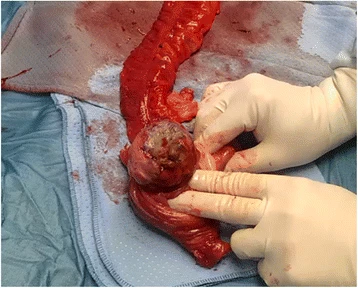This article describes the case of an 8-year-old boy diagnosed as a case of unusual intussusception.
He presented with complaints of abdominal pain with nausea and vomiting, especially after meals. The symptoms were so severe that they gradually gardened complete anorexia. Thus, the patient had severe weight loss and constipation on the day of his admission. However, he did not have any history of fever, chills or any previous abdominal surgeries.
On laboratory investigations, the patient showed elevated CRP levels, indicative of a disease process. Moreover, doctors found multiple small bowel loops distended with gas on the patient’s abdominal X-ray. They then proceeded with sonography to get a detailed image of the affected areas. Focused sonography revealed a target sign or doughnut appearance in the patient’s right lower quadrant. This finding clearly indicated a bowel intussusception.
Abdominal CT Reveals Malignancy in addition to Intussusception
Computerized tomography is used to get high-aspect images that help make a definitive diagnosis. Hence, when doctors conducted an abdominal CT of the patient, they stumbled upon an unusual finding. In addition to having his terminal ileum telescoping into his proximal colon, the patient also had a malignant lesion. This lesion extended from 16 cm of the terminal ileum all the way up to the transverse colon. Even more, doctors also found its metastasis in the liver.
Next, doctors performed an exploratory laparotomy. They found the ileocolic intussusception along with an intraluminal mass. They also observed necrosis and oedema in the affected areas. Another interesting finding was the loss of the classical three layers of the intestinal wall. Furthermore, the patient’s mesenteric nodes were enlarged too.
Resection of the Intussusception and Post-Surgery Outcome
Doctors resected the involved segment with 5 cm margins. They then tied the healthy portions together to form and end anastomosis. Post-procedure, they kept the patient on follow-up where they would monitor the patient for lesions (such as those in the liver) using a contrast CT. Anyhow, they also referred him to the oncology department where he received chemotherapy and is still under follow-up.
The Lesion was a Diffuse Large B Cell Lymphoma
Immunohistochemistry of the resected lesion revealed polymorphic cells positive for markers such as CD10+, CD20+, bcl6+ and other markers coherent with a diffuse large B cell lymphoma. Hence, doctors concluded that this lymphoma caused intussusception in the patient.
Why is this Intussusception Unusual?
Intussusception is not something unusual. In fact, children very often present with this condition. Also, tumours especially those of the large bowel cause intussusception in nearly 68 percent of the cases. However, for all cases, a diffuse large B cell lymphoma has been rarely labelled as a cause of acute abdomen. Clinically, the first sign to look for is intussusception as it plays a significant role in early disease detection.
Diffuse Large B Cell Lymphoma (DLBCL)
DLBCL, the most common type of Non-Hodgkin’s lymphoma, rarely causes obstructive intestinal symptoms to let alone intussusception. Thus when present, the association is demonstrated by the elevated frequency of abdominal symptoms. Most of the time doctors reach a diagnosis while exploring the cause of abdominal disturbances.
Most commonly, DLBCL presents with lymph node involvement but it can also manifest as symptoms related to GIT and CNS. The most common variant is the histiocyte-rich variant, as in our patient, in which the investigators clearly find abundant atypical B cells in the background of normal T cells. Another variant called the primary DLBCL of the CNS presents with nervous symptoms. Many times, DLBCL from another site invades the brain or spinal cord and results in a secondary diffuse large cell lymphoma of the brain. There is also an EBV-associated variant. It usually affects old people and understandably those who are EBV positive. The fourth variant is non-specific as it falls into none of the categories.
Extranodal DLBCL
Diffuse large B cell lymphoma has been also seen in regions like the groin, armpits and even in the salivary glands, nasal sinuses and testes etc. In all these areas, it manifests as a swelling and the symptoms depend upon the amount of pressure that it puts on the tissue. The point here is, that extranodal DLBCL is not uncommon. Still, diffuse large B cell lymphoma in the ileocolic region forcing the terminal ileum into the colon is a rare entity.
Anyhow, doctors usually employ chemotherapy first instead of surgical resection. The reason lies in the fact that the association between surgical options and disease outcomes lacks adequate evidence-based studies. However, surgical resection in conjunction with chemotherapy breeds an improved prognosis.
Although treatment does exist for diffuse large B cell lymphoma, relapses and its transformation into an adenocarcinoma are not uncommon. Especially with the gastric variety, doctors have seen a lymphoma transform into an adenocarcinoma. Thus, there are no standard guidelines for an optimal treatment against primary diffuse large B cell lymphoma.




